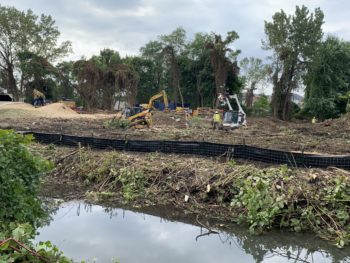
Work on the Bluebelt begins. Image Credit: NYC DEP
Bluebelts improve the health of local waterways and increase nearby property values by managing stormwater and reducing flooding while protecting natural spaces. On October 1, 2020, New York City Department of Environmental Protection Commissioner Vincent Sapienza, Department of Transportation Commissioner Polly Trottenberg, and Department of Design and Construction Commissioner Lorraine Grillo announced that construction began on a $75 million enhancement of the Bluebelt program in the Mid-Island area of Staten Island.
The Bluebelt program is a large system of stormwater management in New York City. The program began in the 1990s in Staten Island, but has since expended to the Bronx and Queens. Bluebelts handle the runoff precipitation that falls onto streets and sidewalks and provide open green spaces for communities and provide a habitat for local wildlife. The program preserves natural drainage systems such as streams, ponds, and wetlands, and enhancing them to convey, store, and filter runoff precipitation or stormwater. Bluebelts offer a solution for stable stormwater management as New York City prepares for rising sea levels and heavier precipitation due to climate change.
The enhancement project includes two projects both funded by DOT and DEP. The first is the “Gateway to the Bluebelt” project. With a budget of $33 million, this project will create a public viewing area and rehabilitate the New Creek wetlands. The viewing area will be located on the south side of Hylan Boulevard and will feature a bench lined walkway that leads to a stone-faced headwall looking over the new wetland with views of lower New York Harbor. The Gateway project will also include planting 219 trees, 607 shrubs, and 23,000 wildflowers and native plants in the area. Currently, crews are in an early phase of the project clearing brush and trees from the future wetlands are.
The second project is the enhancement of the New Creek Bluebelt and the sewer system. With a budget of $42 million and spanning over 21 acres, the project will create the largest man-made wetland area in the Bluebelt system along with two outfalls, stilling basins, a micropool, and a weir. The project also includes cleaning up the area by removing trash and debris and planting more than 85,400 wildflowers and native plants, 810 native shrubs, and 440 trees. The storm sewer system will be updated by installing more than a mile of new storm sewers along portions of Laconia Ave., Mason Ave., Seaver Ave., Filbert Ave., Rowan Ave., Stobe Ave., Jefferson Ave., Adams Ave., Nugent Ave., and Graham Blvd. The sanitary sewer system will be updated by replacing 1,200 feet of old sanitary sewers and installing 870 feet of new sanitary sewers. Once all this construction is complete, stormwater which falls on roadways, rooftops, and sidewalks in parts of Dongan Hills, Grant City, and Tody Hill neighborhoods will drain into the new storm sewers and will be discharged into the Last Chance Pond at the top of the New Creek Bluebelt where the runoff will make its way to the lower New York Harbor.
Both the Gateway project and the New Creek project are scheduled to be completed by 2023.
DOT Commissioner Polly Trottenberg stated, “Increasingly frequent storms like Hurricane Sandy have taught us many painful lessons, but DEP’s Bluebelt program has been a good lesson: we have a relatively low-cost way for Staten Island to prepare for future flooding.”
Photos and a map of the project area can be found here.
By: Lynsey Smith (Lynsey is the CityLaw intern and a New York Law School student, Class of 2022).

